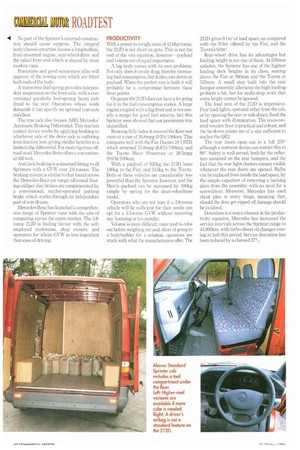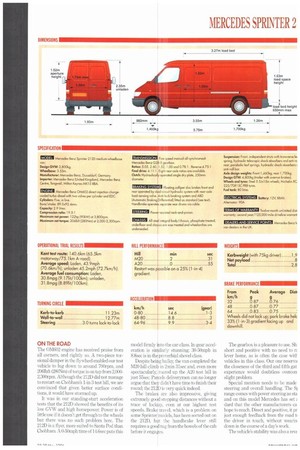SHOOTING STAR
Page 42

Page 44

Page 45

Page 46

If you've noticed an error in this article please click here to report it so we can fix it.
Mercedes-Benz has all the bases covered with its all-encompassing Sprinter range, but is there really a demand for a 2.8-tonner? Judging by the exceptional performance of this week's test vehicle, the answer is a resounding yes...
List price: £16,430.
Engine: 121hp (90kW). GCW: 41800k9. Payload: 850kg. Speed: 70.6km/h (43.9mph). Fuel consumption: 30.8mpg (9.2 lit/100km). The market for 3.5-tonne vans is well established, with a growing number of manufacturers competing for business. Drop the GVW to 2.8 tonnes and the market becomes less clearly defined. Fewer manufacturers produce 3.5-tonne-sized vehicles at this weight, the perception presumably being that if an operator needs a vehicle bigger than a one-tonne panel van he's likely to be a candidate for a 3,5-tonner,
Mercedes-Benz ought disagree with that view. The 2.8-tonne rated Sprinter accounts for 5% of the 7,600 models sold in the UK so far. Dealer returns indicate that the typical purchaser is a one-vehicle operator, demanding a car-type specification with a van payload. Even 5% of a market which is not recognized by many in the van world seems impressive enough, but does a 2.8-tonne vehicle pose a threat to the established markets at weights above and below it?
PRODUCT PROFILE Commercial Motor's test vehicle, the 2121) standard-roof. medium-wheelbase 2.8-tonner. sits towards the lighter end of the Sprinter range: only the 2.59-tonne GVW variants offer
smaller payloads. The 2121) is offered in three versions: a standard (2.3m) roof height on a short (3.0m) or medium (3.55m) wheelbase; and a high (2.55m) roof on the medium wheelbase.
The Sprinter range also includes a longer (4.03m) wheelbase, but only on the heavier 3081) and 3121) models. There are three power options: a 143hp (105kW) 2.3-litre petrol
engine; a 58hp (79kW) naturally aspirated diesel; and, in our 2121), a 122hp (90kW) 2.9-litre charge-cooled turbo-diesel.
This five-cylinder engine, a development of the naturally aspirated unit fitted to the Sprinter's predecessor, has a direct-injection head, designed to reduce emissions and improve efficiency The Bosch distributor pump is controlled by an EDC assembly, rather than a traditional mechanical linkage, using an accelerator pedal which allows "drive-by-wire" control.
The 2121) is fitted with Mercedes G28-5 five-speed gearbox, as are the 3121) and the petrol-engined 214. Drivers with less than fond memories of the cumbersome dog-leg configuration found in the old T1 will delight in the G28-5's conventional shift pattern.
111 No part of the Sprinter's external construe
tion should cause surprise. The integral body/chassis structure houses a longitudinal, front-mounted engine, rear-wheel-drive and the raked front end which is shared by most modern vans.
Pessimists and good samaritans alike will approve of the towing eyes which are fitted both ends of the body A transverse leaf spring provides independent suspension on the front axle, with a conventional parabolic leaf-sprung beam axle fitted to the rear. Operators whose work demands it can specify an optional rear-axle stabiliser.
The rear axle also houses ABD; Mercedes' Automatic Braking Differential, This traction control device works by applying braking to whichever side of the drive axle is suffering from traction loss, giving similar benefits to a limited-slip differential. For more rigorous off. road work Merced-Benz offers a conventional diff-lock.
Anti-lock braking is a standard fitting to all Sprinters with a GVW over 2.6 tonnes. The braking system is similar to that found across the Mercedes-Benz car range: all-round floating-calliper disc brakes are complemented by a conventional, ratchet-operated parking brake which works through an independent pair of rear drums.
Mercedes-Benz has launched a comprehensive range of Sprinter vans with the aim of competing across the enure market. The 2.8tonne 2121) is finding favour with the selfemployed tradesman, shop owners, and operators for whom GM is less important than ease of driving. PRODUCTIVITY With a power-to-weight ratio of 43.6hp/tonne, the 2121) is not short on guts. This is not the end of the van equation, however --payload and volume are of equal importance.
A big body comes with its own problems. Not only does it create drag, thereby increasing fuel consumption, but it also cuts down on payload. When the perfect van is built it will probably be a compromise between these three points.
On paper the 2121) does not have a lot going for it in the fuel consumption stakes. A large engine coupled with a big front end is not usually a recipe for good fuel returns, but this Sprinter soon showed that our pessimism was unjustified.
Running fully laden it covered the Kent test route at a rate of 30.8mpg (9.21itil 00km). This compares well with the Fiat Duaito 10 1.9TD, which returned 31.8mpg (8.8/lit/100km), and the Toyota Hiace Powervan at 28.5mpg (9.9/14/100km), With a payload of 925kg the 2121) loses 180kg to the Fiat, and 345kg to the Toyota. Both of these vehicles are considerably less powerful than the Sprinter, however, and the Merc's payload can be increased by 100kg simply by opting for the short-wheelbase model.
Operators who are not sure if a 2.8-tonne vehicle will be sufficient for their needs can opt for a 3.5-tonne GATW without incurring any licensing or tax penalty Volume is more difficult: vans tend to cube out before weighing out and, short of going to a bodybuilder for a solution, operators are stuck with what the manufacturers offer. The 212D gives 9.lm of load space, as compared with the 9.0tn offered by the Fiat, and the Toyota's 6.0m& Rear-wheel drive has its advantages but loading height is not one of them, At 650nim unladen, the Sprinter has one of the highest loading deck heights in its class, soaring above the Fiat at 560mm and the Toyota at 525mm. A small step built into the rear bumper assembly alleviates the high loading problem a bit, but for multi-drop work that extra height cannot be ignored.
The load area of the 2121) is impressive. Four load lights, operated either from the cab, or by opening the rear or side doors, flood the load space with illumination. The resin-covered wooden floor is practical and robust, and the tie-down points are of a size sufficient to anchor the QF:2.
The rear doors open out to a full 270° although a restraint device can restrict this to 90. Safety is well-served, both by the reflectors mounted on the rear bumpers, and the fact that the rear light clusters remain visible whenever the rear doors are opened. Bulbs can be replaced from inside the load space, by the simple expedient of removing a backing plate from the assembly with no need for a screwdriver. Moreover, Mercedes has used shear pins in every hinge, meaning that, should the door get ripped off damage should be localised.
Downtime is a major element in the productivity equation. Mercedes has increased the service intervals across the Sprinter range to 45,000km, with turbo-diesel oil changes coming at half this period. Service downtime has been reduced by a claimed ON THE ROAD
The OM602 engine has received praise from all corners, and rightly so. A two-piece torsional damper in the flywheel enabled our test vehicle to lug down to around 700rpm, and 2061bft (280Nm) of torque is on tap from 2,0002,30Orpm. Although the 2121) did not manage to restart on Chobham's 1-in-3 test hill, we are convinced that given better surface conditions, it would have stormed up.
It was in our standing-start acceleration tests that the 2121) showed the benefits of its low GM and high horsepower. Power is of little use if it doesn't get through to the wheels but there was no such problem here, The 212D is a flyer, more suited to Santa Pod than Chobham. A 0-50mph time of 14.6sec puts this model firmly into the car-class. In-gear acceleration is similarly stunning; 30-50mph in 8.8sec is in the proverbial shovel class.
Despite being bulky the van completed the M20 hill-climb in 2min 31sec and, even more spectacularly. roared up the A20 test hill in just 55sec. Parcels delivermen can no longer argue that they didn't have time to finish their round; the 2120 is very quick indeed.
The brake are also impressive, giving extremely good stopping distances without a trace of lockup, even at our highest test speeds. Brake travel, which is a problem on some Sprinter models, has been sorted out on the 2121), but the handbrake lever still requires a good tug from the bowels of the cab before it engages. The gearbox is a pleasure to use. Sh: short and positive with no need to ri lever home, as is often the case wift vehicles in this class, Our one reserva the closeness of the third and fifth gat experience would doubtless overcorr slight problem.
Special mention needs to be made steering and overall handling. The St range conies with power steering as sta and on this model Mercedes has set i dard that the other manufacturers ca hope to reach. Direct and positive, it pr just enough feedback from the road t, the driver in touch, without wearin down in the course of a day's work.
The vehicle's stability was also a revf
44 Our test took place during windy conditions but the 212D's roadholding was definitely in the running-on-rails class. 14h-speed stability has been criticised in other models in the Sprinter range, but that does not apply here; at motorway speeds it provided a smoother ride than many saloon cars.
CAB COMFORT The Mercedes cab is practical without being stunning. The driver's seat provides good support, and the dashboard layout is clear and uncluttered.
Storage space is excellent. Two hinged door panels, a big glove box and two door bins swallow up the items which, in many other cabs, would have to find a home on the passenger seats. The seat supports also provide some storage space, although the fuse board is housed underneath the driver's seat, necessitating a wet back if a fuse needs to be changed in the rain. The toolkit lives in a compartment under the floor of the passenger footwell, which is better than having it rattling around behind the seats.
Noise levels were acceptable, but the temporary plywood bulkhead probably contributed to rather than reduced noise from the load space. Along with an excellent heating system and a generally sympathetic environ
ment, the 2121) would be a good choice for a long journey
Safety is well-served by mounting the radio in an accessible position, but smokers may grow to loathe the positioning of the cigar lighter, which, along with the ashtray, sits just inches from the floor. The absence of an airbag as a standard fitting is,we hope, a temporary aberration. SUMMARY Operators who are not too interested in maximum payload but do want a fast, comfortable and flexible vehicle can now stop looking because the Sprinter 2120 leaves the competition standing.
A 3.5-tormer-sized 2.8-tonner may not fall into one of the established van classes but, given thought, we can see the advantages. The 212D is big enough to handle many panel-van jobs while offering driving comfort undreamed of just a few years ago. We can see this vehicle fitting very comfortably into a high-mileage, low-payload operation; express Continental deliveries, for example.
A low purchase price has never been one of Mercedes' main selling points. But while the Sprinter range is too new for an accurate picture of residuals to have formed, given the marques good reputation across its complete product range, it's a reasonable assumption that the 212D will hold its price.
There is a lot of activity in the van market at the moment, and a number of vehicles will be launched over the next few months. Compared with its existing competition the 2120 is excellent. How long this will remain the case will depend on the efforts of the competition. We await developments with interest. El by Oliver Dixon




















































































































